| Revision as of 21:01, 10 July 2009 view sourceEvlekis (talk | contribs)30,289 editsmNo edit summary← Previous edit | Revision as of 04:30, 11 July 2009 view source AmiDaniel (talk | contribs)Extended confirmed users15,065 editsm →Administrative subdivisions: IndentNext edit → | ||
| Line 231: | Line 231: | ||
| * ] | * ] | ||
| * ''']''' | * ''']''' | ||
| * |
** ] | ||
| * |
** ] | ||
| * ] | * ] | ||
| * ] | * ] | ||
Revision as of 04:30, 11 July 2009
For other uses, see the country in Europe.| MontenegroCrna Gora Црна Гора | |
|---|---|
 Flag
Flag
 Coat of arms
Coat of arms
| |
| Anthem: Oj, svijetla majska zoro Montenegrin Cyrillic: Ој, свијетла мајска зоро "Oh, Bright Dawn of May" | |
 Location of Montenegro (green) Location of Montenegro (green) | |
| Capitaland largest city | File:Grb Podgorice2.png Podgorica |
| Official languages | Montenegrin |
| Demonym(s) | Montenegrin |
| Government | Parliamentary republic |
| • President | Filip Vujanović |
| • Prime Minister | Milo Đukanović |
| • Speaker | Ranko Krivokapić |
| Establishment | |
| • Independence of Duklja (Montenegrin predecessor) from Byzantine Empire | 1042 |
| • Duklja recognised as a kingdom by the Pope | 1077 |
| • Zeta (former Duklja) annexed by Serbian Empire | 1186 |
| • Independence of Zeta (later called Montenegro) from Serbian Empire | 1356 |
| • Cetinje founded | 1484 |
| • annexed by the Ottoman Empire, semi-indipendent | 1499 |
| • Independence recognized | 1878 |
| • Self-declared unification with Serbia | 1918 |
| • Independence from Serbia and Montenegro | 2006 |
| Area | |
| • Total | 13,812 km (5,333 sq mi) (160th) |
| • Water (%) | 1.5 |
| Population | |
| • July 2008 estimate | 678,177 (162nd) |
| • 2003 census | 620,145 |
| • Density | 50/km (129.5/sq mi) (121st) |
| GDP (PPP) | 2008 estimate |
| • Total | $6.944 billion |
| • Per capita | $11,092 |
| GDP (nominal) | 2008 estimate |
| • Total | $4.822 billion |
| • Per capita | $7,702 |
| HDI (2006) | 0.822 very high (64th) |
| Currency | Euro (€) (EUR) |
| Time zone | UTC+1 (CET) |
| • Summer (DST) | UTC+2 (CEST) |
| Drives on | Right |
| Calling code | 382 |
| ISO 3166 code | ME |
| Internet TLD | .me (.yu) |
| The traditional old capital of Montenegro is Cetinje. Adopted unilaterally; Montenegro is not a formal member of the Eurozone. .me became active in September 2007. Suffix .yu will exist until September 2009. | |
Montenegro (/ˌmɒntɨˈneɪɡroʊ/ or /ˌmɒntɨˈniːɡroʊ/), (Montenegrin: Crna Gora, Cyrillic: Црна Гора, listen) (meaning "Black Mountain" in Montenegrin) is a country located in Southeastern Europe. It has a coast on the Adriatic Sea to the south-west and is bordered by Croatia to the west, Bosnia and Herzegovina to the northwest, Serbia to the northeast, Kosovo to the east and Albania to the south . Its capital and largest city is Podgorica, while Cetinje is designated as the Prijestonica (Пријестоница), meaning the former Royal Capital City..
The thousand-year history of the Montenegrin state begins in the 9th century with the emergence of Duklja, a vassal state of Byzantium. In those formative years, Duklja was ruled by the Vojislavljevic dynasty. In 1042, at the end of his 25-year rule, King Vojislav won a decisive battle near Bar against Byzantium, and Duklja became independent. Duklja's power and prosperity reached their zenith under King Vojislav's son, King Mihailo (1046-81), and his son King Bodin (1081-1101).. From the 11th century, it started to be referred to as Zeta. It ended with its incorporation into Raska, and beginning with the Crnojevic dynasty, Zeta was more often referred to as Crna Gora or by the Venetian term monte negro. A sovereign principality since the Late Middle Ages, Montenegro saw its independence from the Ottoman Empire formally recognized in 1878. From 1918, it was a part of various incarnations of Yugoslavia. On the basis of a referendum held on 21 May 2006, Montenegro declared independence on 3 June. On 28 June 2006, it became the 192nd member state of the United Nations, and on 11 May 2007 the 47th member state of the Council of Europe. On 15 December 2008, Montenegro presented its official application to the European Union, with the hopes of gaining EU candidate status by 2009.
Name
Crna Gora, sometimes transliterated as Tsrna Gora ("Black Mountain"), is mentioned for the first time in 1296 by Serbian King Stefan Uroš II Milutin in his edict to the Serbian Orthodox Zeta Episcopate seat at the Vranjina island in Lake Skadar from 1296. The origin of the term lies in the Slavic reference to excessively mountainous regions, often emerging in the medieval Serbian realm. Mentioned afterwards in most House of Nemanjić's edicts and in subsequent Venetian sources in the 13th and 14th centuries, signifying the area of the Upper Zeta, the name stabilized itself for a Principality in the second half of the 15th century under Lord Ivan Crnojević, mostly confounding erroneously the term with the dynasty's name, which both have similar roots. The region itself became remembered as Old Montenegro (Стара Црна Гора/Stara Crna Gora) as by the 19th century the The Highlands were added to the state, and Montenegro further increased its size several times by the 20th century during wars against the Ottomans, expanding its name to and annexing Old Herzegovina and parts of Old Serbia, most notably Metohija and southern Rashka. The state changed little to modern day reference, losing Metohija and gaining the Bay of Kotor. The name of the region gave the name to its people, the Montenegrins (Црногорци/Crnogorci).
The country's name in most Western European languages, including English, reflects an adoption of the Italian-Venetian term monte negro, meaning "black mount", which probably dates back to the era of Venetian hegemony over the area in the Middle Ages. Other languages, particularly nearby ones, use their own direct translation of the term "black mountain" (e.g. Albanian: Mali i Zi, Bulgarian: Черна гора, Cherna gora, Czech: Error: {{Lang}}: unrecognized language code: cz (help), Greek: Μαυροβούνιο / Mayrovoúnio, Template:Lang-pl, Romanian: Muntenegru, Slovenian: Črna Gora, Template:Lang-sk, Turkish: Karadağ)). Names from further afield include Template:Lang-ru, Template:Lang-is and Chinese: 黑山 (pinyin: "hēishān".).
The ISO Alpha-2 code for Montenegro is ME and the Alpha-3 Code is MNE.
History
Main article: History of MontenegroAncient Times
The first recorded settlers of present-day Montenegro were Illyrians, the Docleata. In 9 AD the Romans conquered the region of present-day Montenegro. Slavs massively colonized the area in the 5th and 6th centuries, forming a semi-independent principality, Duklja, that was involved in Balkan medieval politics with ties to Rascia and Byzantium and to a lesser extent Bulgaria.
Middle Ages
Duklja gained its independence from the Byzantine Empire in 1042. In the next few decades Duklja expanded its territory to the neighbouring Rascia and Bosnia and also became recognised as a kingdom. Its power started declining at the ending of the 11th century and by 1186, it was conquered by Stefan Nemanja and incorporated into Serbian realm. The newly acquired land, then called Zeta, was governed by the Serbian Nemanjic dynasty. After the Serbian Empire collapsed in the second half of the 14th century, another family came to prominence by expanding their power in the region, the Balšićs. In 1421 it was annexed to the Serbian Despotate, but after 1455 another noble family from Zeta, the Crnojevićs, ruled Montenegro. They were to rule Montenegro until 1499, making it the last free monarchy of the Balkans before it fell to the Ottomans, who annexed it to the sanjak of Skadar. For a short time Montenegro existed as a separate autonomous sanjak in 1514–1528, another version of which existed again some time between 1597 and 1614.
Ottoman Rule and Metropolitanate
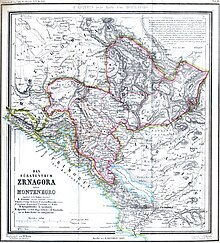
In the 16th century Montenegro developed a form of special and unique autonomy within the Ottoman Empire: the local Montenegrin clans were also free of many bonds due to Montenegro's autonomy. Nevertheless the Montenegrins refused to accept Ottoman reign and in the 17th century raised numerous rebellions, culminating with the Ottoman defeat in the Great Turkish War at the end of that century. Montenegro became a theocracy led by the Montenegrin Orthodox Metropolitans, flourishing since the Petrović-Njegoš became the traditional Prince-Bishops (whose title was "Vladika of Montenegro"). The Venetian Republic introduced governors that meddled in Montenegrin politics; when the republic was succeeded by the Austrian Empire in 1797, the governors were abolished by Prince-Bishop Petar II in 1832. His predecessor Petar I contributed to the unification of Montenegro with the Highlands.
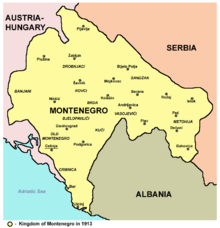
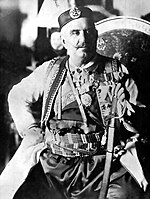
20th Century
Under Nicholas I, the Principality of Montenegro vastly advanced and enlarged several times in the Montenegro-Turkish Wars and achieved recognition of independence in 1878. Modernization of the state followed, culminating with the draft of a Constitution in 1905. Political rifts for the first time emerged between the reigning People's Party that supported democratization of the ruler's autocratic regime and unconditional union with Serbia and the minor pro-monarch True People's Party. In 1910 Montenegro became a Kingdom. It initiated the Balkan wars in 1912 and 1913 in which the Ottomans lost all lands in the Balkans, achieving a common border with Serbia, but the Skadar was awarded to a newly created Albania. In World War I in 1914 Montenegro sided with Serbia against the Central Powers, suffering a full scale defeat to Austria-Hungary in early 1916. In 1918 the Allies liberated Montenegro, which was subsequently merged with Serbia. In 1904 Montenegro declared war on Japan in support of Russia. However, Montenegro inexplicably failed to adhere to the Treaty of Portsmouth in 1905 and so remained at war with Japan until 1918, although no hostilities occurred.
| Part of a series on the |
|---|
| History of Montenegro |
 |
| Prehistory |
| Middle Ages and early modern |
| Modern and contemporary |
| Topics |
In 1922 Montenegro formally became the Zeta Area of the Kingdom of Serbs, Croats and Slovenes, and in 1929 it became a part of a larger Zeta Banate of the Kingdom of Yugoslavia. In World War II Yugoslavia was invaded by the Axis forces in 1941, who established a puppet Independent State of Montenegro, liberated by the Yugoslav Partisans in 1944. Montenegro became a constituent republic of the communist Socialist Federal Republic of Yugoslavia (SFRY), its capital renamed to Titograd in honor of Partisan leader and SFRY president Josip "Tito" Broz. More and more autonomy was established, until the Socialist Republic of Montenegro ratified a new constitution 1974 (however, this RFM remained a constituent republic of the SFRY).
After the dissolution of the SFRY in 1992, Montenegro remained part of a smaller Federal Republic of Yugoslavia along with Serbia.
In the referendum on remaining in Yugoslavia in 1992, 95.96% of the votes were cast for remaining in the federation with Serbia, although the turnout was at 66% because of a boycott by the Muslim, Albanian and Catholic minorities as well as the pro-independence Montenegrins. The opposition claimed that the poll was organized under anti-democratic conditions, during wartime in the former Yugoslavia, with widespread propaganda from the state-controlled media in favor of a pro-federation vote. There is no impartial report on the fairness of the referendum, as the 1992 referendum was totally unmonitored, unlike the 2006 vote, which has been closely monitored by the European Union.
During the 1991–1995 Bosnian War and Croatian War, Montenegrin members of police and military forces participated in the attacks on Dubrovnik, Croatia and Bosnian towns along with Serbian troops, aggressive acts aimed at acquiring more territories by force, characterized by a consistent pattern of gross and systematic violations of human rights.
Montenegrin General Pavle Strugar has since been convicted for his part in the bombing of Dubrovnik. Bosnian refugees were arrested by Montenegrin police and transported to Serb camps in Foča, where they were subjected to systematic torture and executed.
In 1996, Milo Đukanović's government severed ties between Montenegro and the Serbian regime, which was then under Milošević. Montenegro formed its own economic policy and adopted the German Deutsche Mark as its currency. It has since adopted the Euro, though it is not formally part of the Eurozone currency union. Subsequent governments of Montenegro carried out pro-independence policies, originally restored by the Liberal Alliance of Montenegro, and political tensions with Serbia simmered despite the political changes in Belgrade. Targets in Montenegro were bombed by NATO forces during Operation Allied Force in 1999, although the extent of these attacks was very limited in both time and the area affected.
During the Kosovo War, ethnic Albanians took refuge in Montenegro, but were still under threat by Serbian soldiers, who were able to take refugees back into Serbian controlled areas and torture them. In the spring of 1999, 21 Albanians died in several separate and unexplained incidents in Montenegro, according to the republic’s prosecutor. Another group of around 60 Albanian refugees was fired upon in Kaludjerski Laz by Yugoslav Army members, leading to the death of six people, including a woman aged 80 and a child, killed in crossfire that allegedly came from three machine-gun posts of the then Yugoslav Army. In all, 23 Albanians were killed in Kaludjerski Laz, and Montenegrin prosecutors have charged 8 soldiers, among which is Predrag Strugar, son of convicted Montenegrin war criminal General Pavle Strugar, with "inhuman treatment against civilians".
In 2002, Serbia and Montenegro came to a new agreement regarding continued cooperation and entered into negotiations regarding the future status of the Federal Republic of Yugoslavia. In 2003, the Yugoslav federation was replaced in favor of a looser state union named Serbia and Montenegro.
21st Century Independence

The status of the union between Montenegro and Serbia was decided by the referendum on Montenegrin independence on May 21, 2006. A total of 419,240 votes were cast, representing 86.5% of the total electorate. 230,661 votes or 55.5% were for independence and 185,002 votes or 44.5% were against. The 45,659 difference narrowly surpassed the 55% threshold needed to validate the referendum under the rules set by the European Union. According to the electoral commission, the 55% threshold was passed by only 2,300 votes. Serbia, the member-states of the European Union, and the permanent members of the United Nations Security Council have all recognised Montenegro's independence.
The 2006 referendum was monitored by five international observer missions, headed by an OSCE/ODIHR monitoring team, and around 3,000 observers in total (including domestic observers from CEMI, CEDEM and other organizations). The OSCE/ODIHR joined efforts with the observers of the OSCE Parliamentary Assembly (OSCE PA), the Parliamentary Assembly of the Council of Europe (PACE), the Congress of Local and Regional Authorities of the Council of Europe (CLRAE) and the European Parliament (EP) to form an International Referendum Observation Mission (IROM). The IROM—in its preliminary report—"assessed compliance of the referendum process with OSCE commitments, Council of Europe commitments, other international standards for democratic electoral processes, and domestic legislation." Furthermore, the report assessed that the competitive pre-referendum environment was marked by an active and generally peaceful campaign and that "there were no reports of restrictions on fundamental civil and political rights."
On June 3, 2006, the Parliament of Montenegro declared the independence of Montenegro, formally confirming the result of the referendum on independence. Serbia did not obstruct the ruling, confirming its own independence and declaring the union of Serbia and Montenegro ended shortly thereafter.
Relations between Serbia and Montenegro were strained on September 6, 2007 after Montenegro banned Serbian Orthodox Church leader Bishop Filaret from entering the country. The tension escalated when an adviser to the Serbian prime minister called Montenegro a quasi-state, prompting Podgorica to seek an apology and lodge a protest with Serbia's government. The Deputy Prime Minister of Serbia, Božidar Đelić, sent a note of apology to Montenegro following the statement made by Serbian Premier's Aide Aleksandar Simic.
Geography
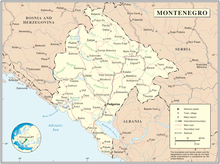

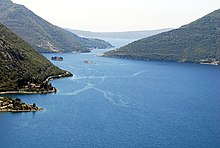
Internationally, Montenegro borders Croatia, Bosnia and Herzegovina, Serbia, and Albania. Historically, its territory was divided into "nahije". Template:Montenegro city
See also: List of cities in MontenegroMontenegro ranges from high peaks along its borders with Serbia and Albania, a segment of the Karst of the western Balkan Peninsula, to a narrow coastal plain that is only one to four miles (6 km) wide. The plain stops abruptly in the north, where Mount Lovćen and Mount Orjen plunge into the inlet of the Bay of Kotor.
Montenegro's large Karst region lies generally at elevations of 1,000 metres (3,281 ft) above sea level; some parts, however, rise to 2,000 metres (6,560 ft), such as Mount Orjen (1,894 m/6,214 ft), the highest massif among the coastal limestone ranges. The Zeta River valley, at an elevation of 500 meters (1,640 ft), is the lowest segment.
The mountains of Montenegro include some of the most rugged terrain in Europe. They average more than 2,000 metres (6,560 ft) in elevation. One of the country's notable peaks is Bobotov Kuk in the Durmitor mountains, which reaches a height of 2,522 metres (8,274 ft). The Montenegrin mountain ranges were among the most ice-eroded parts of the Balkan Peninsula during the last glacial period.
- Longest beach: Velika Plaža, Ulcinj — 13,000 m (8 miles)
- Highest peak: Zla Kolata, Prokletije at 2,534 m
- Largest lake: Skadar Lake — 391 km² (151 sq mi) of surface area
- Deepest canyon: Tara River Canyon — 1,300 m (4,265 ft)
- Biggest bay: Bay of Kotor
- National parks: Durmitor — 390 km² (150 sq mi), Lovćen — 64 km² (25 sq mi), Biogradska Gora — 54 km² (21 sq mi), Skadar Lake — 400 km² (154 sq mi)
- UNESCO World Heritage sites: Durmitor and Tara River Canyon, old city of Kotor.
Government and politics


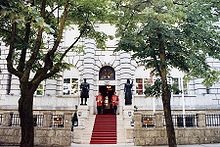
Montenegro is defined as a "Civic, democratic, ecological state of social justice, based on the reign of Law". It is an independent and sovereign Republic. It proclaimed its new Constitution on 22 October 2007.

The President of Montenegro (Montenegrin: Predsjednik Crne Gore) is the head of state, elected for a period of five years through direct elections. The President represents the republic in the country and abroad, promulgates laws by ordinance, calls elections for the Parliament, proposes candidates for the Prime Minister, president and justices of the Constitutional Court to the Parliament, proposes to the Parliament calling of a referendum, grants amnesty for criminal offences prescribed by the national law, confers decoration and awards, and performs all other duties in accordance with the Constitution. The President is also a member of the Supreme Defence Council. Official Residence of President of Montenegro is at Cetinje.
Current President of Montenegro is Filip Vujanović, vice-president of the ruling Democratic Party of Socialists of Montenegro.
The Government of Montenegro (Montenegrin: Vlada Crne Gore) is the executive branch of government authority of Montenegro. The Government is headed by the Prime Minister, and consists of the deputy prime ministers as well as ministers.
Milo Đukanović is the Prime Minister of Montenegro and head of the Government. Government is formed by members of Coalition for a European Montenegro, which was victorious at 2009 parliamentary election.
The Parliament of Montenegro (Montenegrin: Skupština Crne Gore) is the unicameral legislative body. It passes all laws in Montenegro, ratifies international treaties, appoints the Prime Minister, ministers, and justices of all courts, adopts the budget and performs other duties as established by the Constitution. The Parliament can pass a vote of no-confidence on the Government by a majority of the members. One representative is elected per 6,000 voters, which in turn results in a reduction of total number of representatives in the Parliament of Montenegro.
The current president of the Parliament is Ranko Krivokapić. The present parliament contains 81 seats. According to 2009 parliamentary election, Coalition for a European Montenegro has the majority in Parliament of Montenegro, with 47 out of 81 seats.
Symbols
A new official flag of Montenegro was adopted on July 13 2004, by the Montenegrin legislature. The new flag is based on the royal standard of King Nikola I of Montenegro. This flag was all red with a silver border, a silver coat of arms, and the initials НІ in Cyrillic script (corresponding to NI in Latin script) representing King Nikola I. The border and arms were changed from silver to gold in the modern flag and the royal cypher in the centre of the arms are omitted from the modern arms and replaced with a golden lion.
The national day of 13 July marks the date in 1878 when the Congress of Berlin recognised Montenegro as the 27th independent state in the world and the start of one of the first popular uprisings in Europe against the Axis Powers on 13 July 1941 in Montenegro.
In 2004, the Montenegrin legislature selected a popular Montenegrin traditional song, Oh, Bright Dawn of May, as the national anthem. Montenegro's official anthem during the reign of King Nikola was Ubavoj nam Crnoj Gori (To our beautiful Montenegro). The Montenegrin popular anthem has unofficially been Onamo, 'namo! since King Nikola I wrote it in the 1860s.
Administrative subdivisions
Main article: Municipalities of MontenegroMontenegro is divided into twenty-one municipalities (opština), and two urban municipalities, subdivisions of Podgorica municipality:

|
Military
The Military of Montenegro is composed of Land Forces, Navy and Air force, with a Special forces component. As of 2009 it is organized as a fully professional standing army. It works under the Ministry of Defense with the aim of protecting and defending Montenegro and its sovereignty. Montenegro's goal is to eventually join NATO after modernization and reorganization of its military.. Future plans for the army are to participate more in peacekeeping missions through various United Nations and NATO peacekeeping missions like ISAF. Montenegro's only mission for now is UNMIL in Liberia, as military observers.
Economy
Main article: Economy of Montenegro See also: Tourism in Montenegro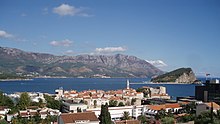
The economy of Montenegro is mostly service-based market economy in late transition. According to IMF, nominal GDP of Montenegro was $4.822 billion in 2008. The GDP PPP for 2008 was $6.944 billion, or $11,091 per capita.
Although GDP grew at impressive 10,7% in 2007, a slowdown is expected due to late-2000s recession.
In 2007, service sector made up for 72,4% of GDP, industry was second largest contributor with 17,6%, trailed by agriculture at 10% .
According to Eurostat data, Montenegrin PPS GDP per capita stood at 46 per cent of the EU average in 2008.
Aluminum and steel production and agricultural processing make up for most of Montenegrin industry.
Tourism is an important contributor to Montenegrin economy. Approximately one million tourists visited Montenegro in 2007, resulting in €480 million of tourism revenue. Tourism is the backbone of future economic development strategy for Montenegro.
The growth of the Montenegrin economy may be hampered by significant dependence on foreign direct investment, and thus susceptibility to external shocks and high export/import trade deficit .
Infrastructure
Main article: Transport in MontenegroMontenegrin road infrastructure is not on par with European standards. Although road network is extensive, there are no roads built to full motorway standard. The projects that should change that fact include Bar - Boljare motorway and Montenegrin section of Adriatic Ionian motorway. Building of those motorways is considered as national priority, as both are important for uniform regional economic development of Montenegro, and development of Montenegro as an elite tourist destination.
Current European routes that pass through Montenegro are E65 and E80.
The backbone of Montenegrin rail network is Belgrade - Bar railway. This railway intersects with Nikšić - Tirana at Podgorica, however, this railway is not used for passenger service.
Montenegro has two international airports, at Podgorica and Tivat. The two airports served 1,1 million passengers in 2008. Montenegro Airlines is flag carrier of Montenegro.
The Port of Bar is Montenegro's main seaport.
Tourism
Main article: Tourism in MontenegroMontenegro is well suited for development of all kinds of tourism, as it has both a picturesque coast and a mountainous northern region. The country was a well-known tourist spot in the 1980s, yet, the Yugoslav wars that were fought in neighboring countries during the 1990s crippled the tourist industry and destroyed the image of Montenegro as a tourist destination.
It was not until 2000s that the tourism industry began to recover, and the country has since experienced a high rate of growth in the number of tourist visits and overnight stays. The Government of Montenegro has set the development of Montenegro as an elite tourist destination a top priority. It is a national strategy to make tourism a major, if not the single largest, contributor to the Montenegrin economy. A number of steps were taken to attract foreign investors into Montenegro's tourism industry. Some large projects are already under way, such as Porto Montenegro, while other locations, like Jaz Beach, Buljarica, Velika Plaža and Ada Bojana, have perhaps the greatest potential to attract future investments and become premium tourist spots on the Adriatic. Some of the problems that currently hamper the development of Montenegrin tourism are inadequate infrastructure, notably the road infrastructure in the north, and electricity and water supply in the south of the country. The informal construction is also a problem.
-
 Miriste Beach, Herceg Novi
Miriste Beach, Herceg Novi
-
 King Nikola's Palace, Bar
King Nikola's Palace, Bar
-
 Lake Biograd, Kolašin
Lake Biograd, Kolašin
-
 View of Budva
View of Budva
-
 The Castle of Ulcinj
The Castle of Ulcinj
-
A view of Sveti Stefan island in the Budva municipality.
-
 Biogradska Gora, a forest and a national park in Kolašin.
Biogradska Gora, a forest and a national park in Kolašin.
-
 Tara River Canyon, longest canyon in Europe and the second-longest in the world.
Tara River Canyon, longest canyon in Europe and the second-longest in the world.
Demographics
Main articles: Demographics of Montenegro and Demographic history of Montenegro
Ethnicity
According to 2003 census, Montenegro has 620,145 citizens. If the methodology used up to 1991 had been adopted in the 2003 census, Montenegro would officially have recorded 673,094 citizens. Most recent estimates stake somewhere below 700,000 inhabitants.
When the census was taken Montenegro was a non-national civic state. In the meantime, the Constitution was changed, hence it now recognizes the major ethnic groups living in it: Montenegrins, Serbs, Bosniaks, Albanians, Muslims and Croats. It should be noted that division between Montenegrins and Serbs is mainly on the basis of political identification. Thus, the number of "Montenegrins" and "Serbs" fluctuates wildly from census to census, not due to real changes in the populace, but due to changes in how people experience their identity.
Ethnic composition according to the 2004 official data:
| Number | % | |
| TOTAL | 620,145 | 100 |
| Montenegrins | 267,669 | 43.16 |
| Serbs | 198,414 | 31.99 |
| Bosniaks | 48,184 | 7.77 |
| Albanians | 45,163 | 5.03 |
| Ethnic Muslims | 24,625 | 3.97 |
| Croats | 6,811 | 1.1 |
| Roma | 2,601 | 0.42 |
| Yugoslavs | 1,860 | 0.3 |
| others | 38,818 | 6.26 |
According the newest report, there are 24,610 total refugees from the Yugoslav wars in Montenegro, forming 4.2% of the total population. 16,136 are refugees from Kosovo after 1999 and 8,474 expelled from Croatia and Bosnia.
Language
Most citizens speak the Serbian language of the Iyekavian dialect. However, as of 2004 the moves for an independent Montenegrin language were promoted and with the new 2007 Constitution it became Montenegro's prime official language. Next to it, Serbian, Bosnian, Albanian and Croatian are recognized in usage. All of these languages except for Albanian are virtually identical in common usage.
| Number | % | |
| TOTAL | 620,145 | 100 |
| Serbian | 393,740 | 63.49 |
| Montenegrin | 136,208 | 21.96 |
| Bosnian/Bosniac | 34,078 | 5.49 |
| Albanian | 32,603 | 5.26 |
| Croatian | 2,791 | 0.45 |
| other | 20,725 | 3.34 |
Religion
Most Montenegrin inhabitants are Orthodox Christians, followers of the Serbian Orthodox Church's Metropolitanate of Montenegro and the Littoral. The religious institutions all have guaranteed rights and are separate from the state. There is a sizeable number of Sunni Muslims in Montenegro that maintain their own Islamic Community of Montenegro. There is also a small Roman Catholic population, divided between the Archdiocese of Antivari headed by Primate of Serbia and the Diocese of Kotor that is a part of the Church of Croatia. Religious determination according to the census:
| Number | % | |
| TOTAL | 620,145 | 100 |
| Orthodox | 460,383 | 74.24 |
| Muslim | 110,034 | 17.74 |
| Roman Catholic | 21,972 | 3.54 |
| other | 27,756 | 4.48 |
Culture
Main article: Culture of Montenegro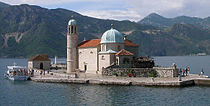

The culture of Montenegro has been shaped by a variety of influences throughout history. The influence of Orthodox, Slavonic, Central European, Islamic, and seafaring Adriatic cultures (notably parts of Italy, like the Republic of Venice) have been the most important in recent centuries.
Montenegro has many significant cultural and historical sites, including heritage sites from the pre-Romanesque, Gothic and Baroque periods. The Montenegrin coastal region is especially well known for its religious monuments, including the Cathedral of Saint Tryphon in Kotor (Cattaro under the Venetians), the basilica of St. Luke (over 800 years), Our Lady of the Rocks (Škrpjela), the Savina Monastery and others. Montenegro's medieval monasteries contain thousands of square metres of frescos on their walls.
The traditional folk dance of the Montenegrins is the Oro, a circle dance that involves dancers standing on each other's shoulders in a circle while one or two dancers are dancing in the middle.
The first literary works written in the region are ten centuries old, and the first Montenegrin book was printed five hundred years ago. The first state-owned printing press was located in Cetinje in 1494, where the first South Slavic book, Oktoih, was printed the same year. Ancient manuscripts, dating from the thirteenth century, are kept in the Montenegrin monasteries.
Montenegro's capital Podgorica and the former royal capital of Cetinje are the two most important centers of culture and the arts in the country.
Ethical Beliefs
A very important dimension of Montenegrin culture is the ethical ideal of Čojstvo i Junaštvo, "Humanity and Gallantry" Another result of its centuries long warrior history, it is the unwritten code of Chivalry that stipulates that to deserve a true respect by those around him, a person has to show virtues of integrity, dignity, humility, self-sacrifice for the just cause, respect for others, and Rectitude along with bravery. In the old days of battle, it resulted in Montenegrins fighting to the death as being captured was considered the greatest shame.
This code of conduct is still very much ingrained, to a greater or lesser extent, in every Montenegrin's ethical beliefs system and it is essential that it be kept in mind in order to truly understand them. Coming from non-warrior backgrounds, most of other South-Slavic nations never fully grasp it, resulting in reactions from totally ignoring it, in the best case, to mocking it or ignorantly equating it with backwardness.
Most extraordinary examples of Montenegrin conduct during its long history can be traced to the code.
Education
Main article: Education in MontenegroEducation in Montenegro is regulated by the Montenegrin Ministry of Education and Science.
Education starts in either pre-schools or elementary schools. Children enroll in elementary schools (Montenegrin: Osnovna škola) at the age of 6; it lasts 9 years. The students may continue their secondary education (Montenegrin: Srednja škola), which lasts 4 years (3 years for trade schools) and ends with graduation (Matura). Higher education lasts with a certain first degree after 3 to 6 years.
Sport
Main article: Sport in MontenegroSerbia and Montenegro were represented by a single football team in the 2006 FIFA World Cup tournament, despite having formally split just weeks prior to its start. Following this event, this team has been inherited by Serbia, while a new one was organized to represent Montenegro in international competitions. On March 24, 2007, the Montenegrin national team came from behind to win its first ever fixture, 2-1, in a friendly game against Hungary at the Podgorica Stadium. On their 119th Session in Guatemala City in July 2007, the International Olympic Committee granted recognition and membership to the newly formed Montenegrin National Olympic Committee. Montenegro made its debut at the 2008 Summer Olympics in Beijing.
Water polo is one of the most popular sports in the country. Montenegro won the European Championships in Malaga, Spain on July 13, 2008 over Serbia 6-5 in a game that was tied 5-5 after four quarters. This was Montenegro's first major international competition for which they had to qualify through two LEN tournaments. Montenegro won the gold medal at the 2009 FINA Men's Water Polo World League which was held in Podgorica, capital city. Montenegrin team PVK Primorac from Kotor became a champion of Europe at the LEN Euroleague 2009 in Rijeka, Croatia. Montenegro’s first division in water polo consists of five clubs, all with an annual budget of one million Euros and more - VK Primorac Kotor (2007 and 2008 Montenegro champions), VK Jadran Herceg Novi (2006 champions of Serbia-Montenegro), VK Budvanska Rivijera Budva, VK Prcanj and VK Bijela. From the coming season 2008-09 they will be joined by a sixth club, VK Cattaro. They qualified for the 2008 Olympic Games in Beijing but did not win.
In popular culture
The first official international representation of Montenegro as an independent state was in the Miss World 2006 celebrated on September 30, 2006 in Warsaw, Poland. Ivana Knežević from the city of Bar was the first Miss Montenegro at any international beauty pageant. Both Montenegro and Serbia competed separately in this pageant for the first time after the state union came to an end.
Part of the 2006 James Bond film Casino Royale is set in Montenegro, although most the filming was done in Czech Republic.
Nero Wolfe, the eccentric fictional detective created by American writer Rex Stout, is Montenegrin by birth. One Nero Wolfe novel, The Black Mountain, takes place in Tito-era Montenegro.
Jay Gatsby, the main character of the F. Scott Fitzgerald novel The Great Gatsby, had been given a medal of honour by the Montenegrin King Nicholas I.
The setting for Franz Lehár 1905 operetta The Merry Widow is the Paris embassy of the Grand Duchy of Pontevedro. Pontevedro is a fictionalized version of Montenegro and several of the characters were loosely based on actual Montenegrin nobility.
Montenegrin holidays
| Date | Name | Notes |
|---|---|---|
| 1 January | New Year's Day | (non-working holiday) |
| 7 January | Orthodox Christmas | (non-working) |
| 2 April | Orthodox Good Friday | Date for 2010 only |
| 4 April | Orthodox Easter | Date for 2010 only |
| 5 April | Orthodox Easter Monday | Date for 2010 only |
| 1 May | Labour Day | (non-working) |
| 9 May | Victory Day | |
| 21 May | Independence Day | (non-working) |
| 13 July | Statehood Day | (non-working) |
See also
Main article: Outline of MontenegroColumn-generating template families
The templates listed here are not interchangeable. For example, using {{col-float}} with {{col-end}} instead of {{col-float-end}} would leave a <div>...</div> open, potentially harming any subsequent formatting.
| Type | Family | Handles wiki table code? |
Responsive/ mobile suited |
Start template | Column divider | End template |
|---|---|---|---|---|---|---|
| Float | "col-float" | Yes | Yes | {{col-float}} | {{col-float-break}} | {{col-float-end}} |
| "columns-start" | Yes | Yes | {{columns-start}} | {{column}} | {{columns-end}} | |
| Columns | "div col" | Yes | Yes | {{div col}} | – | {{div col end}} |
| "columns-list" | No | Yes | {{columns-list}} (wraps div col) | – | – | |
| Flexbox | "flex columns" | No | Yes | {{flex columns}} | – | – |
| Table | "col" | Yes | No | {{col-begin}}, {{col-begin-fixed}} or {{col-begin-small}} |
{{col-break}} or {{col-2}} .. {{col-5}} |
{{col-end}} |
Can template handle the basic wiki markup {| | || |- |} used to create tables? If not, special templates that produce these elements (such as {{(!}}, {{!}}, {{!!}}, {{!-}}, {{!)}})—or HTML tags (<table>...</table>, <tr>...</tr>, etc.)—need to be used instead.
References
- CIA World Factbook: Montenegro
- ^ "Montenegro". International Monetary Fund. Retrieved 2009-04-22.
- http://maps.google.co.uk/maps?hl=en&tab=wl&q=goo
- Basic data of Montenegro
- http://www.montenegro.org/duklja.html
- http://www.montenegro.org/balsic.html
- List of members to the United Nations by joining date
- Directorate of Communication - The Republic of Montenegro becomes 47th Council of Europe member state
- Montenegro files EU membership application
- Geography
- this literal translation is used in Mainland China and Hong Kong; Taiwanese Mandarin uses 蒙特內哥羅 "méngtènèigēluó", a phonetic transcription of "Montenegro"
- ISO 3166-1 Newsletter No. V-12, Date: 2006-09-26
- http://www.croatiatraveller.com/southern_dalmatia/Dubrovnik/bombing.html
- http://www.un.org/documents/ga/res/47/a47r121.htm
- http://www.yihr.org/uploads/newsletters/eng/28.pdf
- http://www.ess.uwe.ac.uk/comexpert/ANX/VIII-03.htm#III.A.25
- "Porodica Nedžiba Loje o Njegovom Hapšenju i Deportaciji 1992". Godine
- "Russia pushes peace plan". BBC. 1999-04-29.
- http://www.independent.co.uk/news/war-in-the-balkans-montenegro--albanian-refugees-tortured-by-serbs-1090436.html
- http://kosovo.birn.eu.com/en/1/70/3221/
- http://www.reuters.com/article/worldNews/idUSL152349220080801
- BBC News: Montenegro vote result confirmed
- BBC News: Montenegro declares independence
- http://english.people.com.cn/90001/90777/6257839.html
- http://www.mfa.gov.yu/Policy/Minister/100907_e.html
- Vijesti: Crna Gora tražila javno izvinjenje zbog afere "kvazidržava"
- President Vujanovic’s Closing Speech at the Crans Montana Forum
- Cilj Crne Gore članstvo u NATO
- Spremaju se za Avganistan
- ^ "5. Report for Selected Countries and Subjects". April 2009.
- "Montenegro at a glance" (PDF).
- "GDP per capita in PPS" (PDF). Eurostat. Retrieved 2009-06-25.
- Montenegrin Census' from 1909 to 2003
- Official results of the 2003 Montenegrin census
- Kotor
- Montenet - History of Montenegro: Crnojevic Rule
- Чојство и јунаштво старих Црногораца, Цетиње 1968. 3-11.
- OBLIKOVANJE CRNOGORSKE NACIJE U DOBA PETROVICA NJEGOSA, "Cojstvo je osobeno svojstvo Crnogoraca, koje su uzdigli u najvecu vrlinu i uzor."
- UEFA: Montenegro set for big adventure
- Montenegro take a bow at victory
^ Montenegrin Ministry of Foreign Affairs 2006 census -
Further reading
- Realm of the Black Mountain: A History of Montenegro by Elizabeth Roberts (Hurst & Co, 2007) ISBN 978-1-85065-868-9
- Montenegro: The Divided Land by Thomas Fleming (2002) ISBN 0-9619364-9-5
External links
- Government
- General information
- "Montenegro". The World Factbook (2025 ed.). Central Intelligence Agency.
- Montenegro from UCB Libraries GovPubs
- Template:Dmoz
- Republic of Montenegro
 Wikimedia Atlas of Montenegro
Wikimedia Atlas of Montenegro- Template:Wikitravel
- Economy portal MONTENEGROWING.ME
- Other
- Photogallery - Montenegro's nature
- Montenegro Pictures – Montenegro Cultural Heritage
- Montenegro Video Portal – Tourism website with HD Video
- Whats On in Ulcinj City News and Informations
- Information and News for Montenegro's South Coast Region
| Montenegro articles | |||||||
|---|---|---|---|---|---|---|---|
| History |
| ||||||
| Geography | |||||||
| Politics | |||||||
| Economy | |||||||
| Society |
| ||||||
| International membership | |||||||||||||||||||||||||||||||||||||||||||||||||||||||||||||||||||||||||||||||
|---|---|---|---|---|---|---|---|---|---|---|---|---|---|---|---|---|---|---|---|---|---|---|---|---|---|---|---|---|---|---|---|---|---|---|---|---|---|---|---|---|---|---|---|---|---|---|---|---|---|---|---|---|---|---|---|---|---|---|---|---|---|---|---|---|---|---|---|---|---|---|---|---|---|---|---|---|---|---|---|
Template:Members of the Union for the Mediterranean
| |||||||||||||||||||||||||||||||||||||||||||||||||||||||||||||||||||||||||||||||
| Council of Europe | |
|---|---|
| Institutions | |
| Members |
|
| Observers | |
| Former members | |